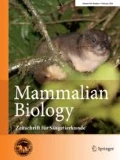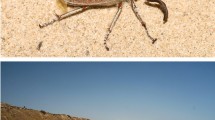Abstract
Dipodomys gravipes is distributed only in the San Quintin plains, in the northwest of the peninsula of Baja California, México; this species is known to prefer flat areas and undisturbed sites. The San Quintin region has experienced accelerated agricultural development over the past 20 years, diminishing the populations of D. gravipes, which is listed as possibly extinct in its environment. In 2017, specimens from two sites were found after a 32-year lack of records. The aim of this work was to identity sites with habitat suitability where D. gravipes could be found, and conduct fieldwork to search for the D. gravipes in the sites with high suitability. The selection of sites was based on ecological niche models. We conducted a reclassification to obtain a “habitat suitability map”. In this map, we selected 30 sites to be surveyed in the field in search of D. gravipes using Sherman traps. A field surveys was conducted in October 2017. Sampling was not successful for D. gravipes. Following the results of the analyses, conditions with flat areas and undisturbed sites only occur in 1.6% of the historical distribution (37.3 km2). On the other hand, although no specimens of D. gravipes were found, the sites derived from the methodology developed in this work set the basis for future searches or to select areas where this species can be reintroduced if rediscovered. It is necessary and urgent to know the sites and conditions in which D. gravipes is present to support any proposal for its conservation.



Similar content being viewed by others
Abbreviations
- ENM:
-
Ecological niche modeling
- fc:
-
Feature class
- rm:
-
Regularization multiplier
- L:
-
Linear
- Q:
-
Quadratic
- H:
-
Hinge
- P:
-
Product
- T:
-
Threshold
- AUC:
-
Area under curve
- OR:
-
Omission rate
- AIC:
-
Akaike information criteria
- SDNHM:
-
San Diego Natural History Museum
- CIBNOR:
-
Centro de Investigaciones Biológicas del Noroeste
References
Álvarez-Castañeda ST, Castro-Arrellano I, Lacher T (2008) Dipodomys gravipes. The IUCN Red List of Threatened Species 2008. https://doi.org/10.2305/IUCN.UK.2018-1.RLTS.T6676A22227742(Downloaded on 22 June 2017)
Álvarez-Castañeda ST, Álvarez T, González-Ruiz N (2017) Keys for identifying Mexican Mammals. The Johns Hopkins University Press, Baltimore
Aguirre A, Contreras B, De La Cueva H, González S, Martínez Ríos L, Martínez V, Montés C, Palacios E, Esparza RP, Salazar M, Serrano J (1999) Opinión técnica sobre los proyectos turísticos “Cabo San Quintín” y “Bay Shores”, en Bahía San Quintín, Baja California. Centro de Investigación Científica y Educación superior de Ensenada (CICESE), El Colegio de la Frontera Norte (COLEF), Instituto Nacional de Antropología e Historia (INAH), Pro Esteros, Ensenada, Baja California
Best TL (1983) Morphologic variation in the San Quintin kangaroo rat (Dipodomys gravipes Huey 1925). Am Midl Nat 109:409–413
Best TL, Lackey JA (1985) Dipodomys gravipes. Mamm Species 236:1–4
Bond WJ (1993) Keystone species. In: Schulze ED, Mooney HA (eds) Biodiversity and ecosystem function, 1st edn. Springer-Verlag, Berlin, pp 237–253
Camargo I, Álvarez-Castañeda ST (2018) Rediscovery of the extinct tule shrew (Sorex ornatus juncensis) in the San Quintin plains: a taxonomic reevaluation after 90 years without new records. Mammalia 83:1–5
Colding J, Folke C (1997) The relations among threatened species, their protection, and taboos. Conserv Ecol 1:6
Cuervo-Robayo AP, Téllez-Valdés O, Gómez M, Venegas-Barrera C, Manjarrez J, Martínez-Meyer E (2013) An update of high-resolution monthly climate surfaces for Mexico. Int J Climatol 34:2427–2437
Dormann CF, Elith J, Bacher S, Buchmann C, Carl G, Carré G, García Marquéz JR, Gruber B, Lafourcade B, Leitão PJ, Münkemüller T, McClean C, Osborne PE, Reineking B, Schröder B, Skidmore AK, Zurell D, Lauthenbach S (2012) Collinearity: a review for methods to deal with it and a simulation study evaluating their performance. Ecography 36:27–46
Franklin J (2013) Species distribution models in conservation biogeography: developments and challenges. Divers Distrib 19:1217–1223
Gallardo García M (2010) Reestructuración productiva en la horticultura del Valle de San Quintín, Baja California, y su impacto en la generación de empleo de 1994 a 2008. M.S. Thesis, El Colegio de la Frontera Norte, A.C. México
Garduño E, García E, Morán P (1989) Mixtecos en Baja California: El caso de San Quintín. Universidad Autónoma de Baja California, México
Grinell J (1917) The niche-relationships of the California Thrasher. Auk 4:427–433
Guisan A, Zimmermann NE (2000) Predictive habitat distribution models in ecology. Ecol Model 135:147–186
Jiménez-Valverde A, Peterson AT, Soberón J, Overton JM, Aragón P, Lobo JM (2011) Use of niche models in invasive species risk assessments. Biol Invasions 13:2785–2797
Koleff P, Urquiza-Hass T (2011) Planeación para la conservación de la biodiversidad terrestre en México: retos en un país megadiverso. CONABIO-CONANP, México
Huey LM (1925) Two new kangaroo rats of the genes Dipodomys from lower California. Proc Biol Soc Wash 38:83–85
Lidicker WZ Jr (1989) Rodents—a World Survey of species of conservation concern. IUCN/SSC, Gland
Loyn R, McNabb EG, Volodina D, Willing R, Jenness J (2004) Predicting low distributions: spatial modeling as a tool for conserving owls in ecologically sustainable forest management in Victoria Australia. In: Rodríguez-Estrella R, Bojórquez-Tapia LA (eds) Spatial analysis in raptor ecology and conservation, 1st edn. CIBNOR - CONABIO, México D.F., pp 111–132
Mellink E (1992) Status de los heterómidos y cricétidos endémicos del estado de Baja California. Comunicaciones académicas. CICESE, Ensenada, B.C
Mellink E (2002) El límite Sur de la Región Mediterránea de Baja California, con base en sus tetrápodos endémicos. Acta Zool Mex 85:11–23
Morales N (2012) Modelos de distribución de especies: software Maxent y sus aplicaciones en conservación. Rev Conserv Ambient 2:1–5
Moreno Mena JA (1999) Flexibilización y precariedad en los mercados de trabajo agrícolas de Baja California in Primer Foro de trabajo en el campo michoacano, CIDEN, SEDESOL, Jornaleros Agrícolas, Colegio de Michoacán, México
Muscarella R, Galante PJ, Soley-Guardia M, Boria RA, Kass JM, Uriarte M, Anderson RP (2014) ENMeval: an R package for conducting spatially independent evaluations and estimating optimal model complexity for Maxent ecological niche models. Methods Ecol Evol 5:1198–1205
Norma Oficial Mexicana (NOM-059-SEMARNAT-2010) (2010) Protección ambiental-especies nativas de México de flora y fauna silvestres—categorías de riesgo y especificaciones para su inclusión, exclusión o cambio—lista de especies en riesgo. Diario oficial
Nowak RM (1999) Walker's Mammals of the World. Johns Hopkins University Press, Baltimore
Patton JL, Álvarez-Castañeda ST (1999) Family Heteromyidae. In: Álvarez-Castañeda ST, Patton JL (eds) Mamíferos del Noroeste Mexicano. Centro de Investigaciones Biológicas del Noroeste, SC, México, pp 351–443
Pearson RG (2007) Species distribution modeling for conservation educators and practitioners. Synthesis. American Museum of Natural History. https://ncep.amnh.org. Accessed 12 Jun 2017
Peterson AT (2014) Mapping disease transmission risk. Johns Hopkins University Press, Baltimore
Phillips SJ, Anderson RP, Schapire RE (2006) Maximum entropy modeling of species geographic distributions. Ecol Model 190:231–259
R Core Team (2017) R: a language and environment for statistical computing. R Foundation for Statistical Computing, Vienna
Searcy CA, Shaffer HB (2016) Do ecological niche models accurately identify climatic determinants of species ranges? Am Nat 187:423–435
Secretaría De Fomento Agropecuario (SEFOA) (2015) Panorama general de “zona San Quintín” Baja California. Online document. http://www.oeidrus-bc.gob.mx/oeidrus_bca/pdf/biblioteca/panoramas/2015/FICHA%20SAN%20QUINTIN%202015.pdf. Accessed 15 Nov 2019
Soberón J, Nakamura M (2009) Niches and distributional areas: concepts, methods, and assumptions. Proc Natl Acad Sci USA 106:19644–19650
Tremor S, Vanderplank S, Mellink E (2019) The San Quintín Kangaroo rat is not extinct. Bull South Calif Acad Sci 118:71–75
Vanderplank S, Ezcurra E, Delgadillo J, Felger R, McDade LA (2014) Conservation challenges in a threatened hotspot: agriculture and plant biodiversity losses in Baja California. Mex Biodivers Conserv 23:2173–2182
Zlolniski C (2010) Economic globalization and changing capital-labor relations in Baja California’s fresh-produce industry. In: Durrenberger EP, Reichart R (eds) The anthropology of Labor. Unions University Press of Colorado and Utah State University Press, Utah, pp 157–188
Acknowledgements
We thank Issac Camargo, Eduardo Aguilera, and Jairo Carlin for their valuable support in field and laboratory work. Thanks also to Consejo Nacional de Ciencia y Tecnología for financial support. María Elena Sánchez-Salazar contributed to the edition of the English manuscript.
Author information
Authors and Affiliations
Corresponding authors
Additional information
Publisher's Note
Springer Nature remains neutral with regard to jurisdictional claims in published maps and institutional affiliations.
Handling editor: Adriano Martinoli.
Electronic supplementary material
Below is the link to the electronic supplementary material.
Rights and permissions
About this article
Cite this article
Cab-Sulub, L., Álvarez-Castañeda, S.T. Analysis of the remaining habitat of an endemic species rediscovered. Mamm Biol 100, 307–314 (2020). https://doi.org/10.1007/s42991-020-00023-z
Received:
Accepted:
Published:
Issue Date:
DOI: https://doi.org/10.1007/s42991-020-00023-z




